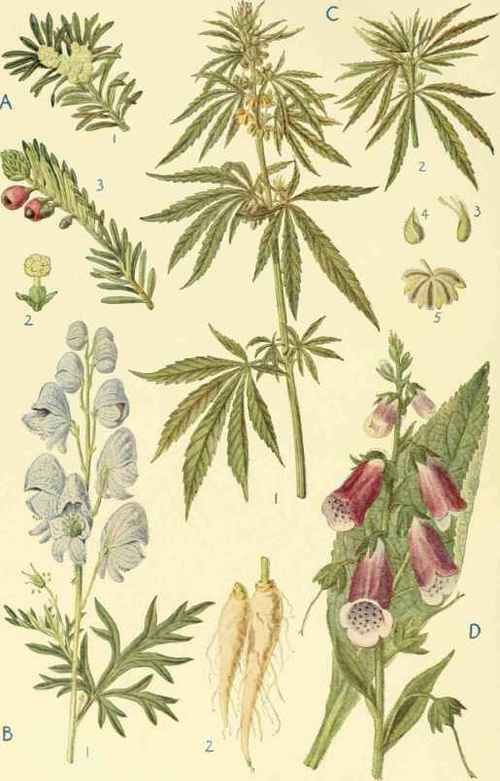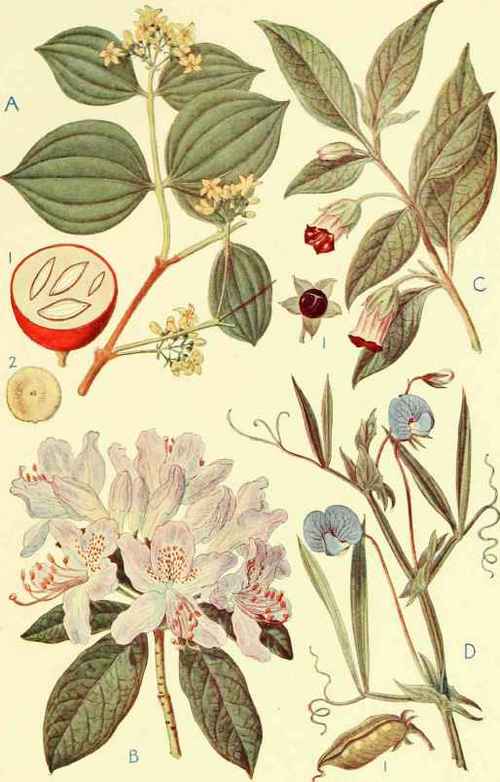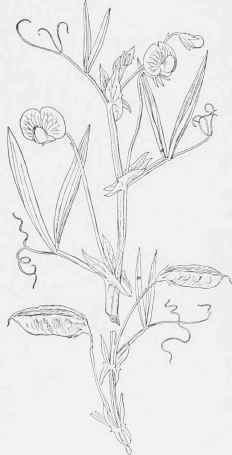Indian Pea. Dog-Tooth Pea Poisoning
Description
This section is from the book "The Horse - Its Treatment In Health And Disease", by J. Wortley Axe. Also available from Amazon: The Horse. Its Treatment In Health And Disease.
Indian Pea. Dog-Tooth Pea Poisoning
We have employed the popular term for this dangerous food-stuff, but it is not a pea; it is a vetch, and its botanical name is Lathyrus sativus. In India this seed has been used as a food-stuff among the lower-caste natives, among whom it has produced from time to time considerable mortality; but when thoroughly cooked it is consumed in moderation without producing any deleterious effects.

POISONOUS PLANTS-I.
A. Yew. 1. Male. 2. Male flower. 3. Fruit.
B. Aconite. 1. Plant. 2. Roots.
C. Indian Hemp. 1. Male. 2. Female. 3. Female flower. 4. Fruit. 5. Male flower.
D. Foxglove.

POISONOUS PLANTS - II.
A. Nux Vomica, 1. Section of fruit. 2. Seed.
B. Rhododendron.
C. Belladonna. 1. Fruit.
D. Indian Pea. 1. Fruit.
It does not appear to have been known in this country until the year 1889, but is now generally recognized by veterinary surgeons as a highly dangerous grain to form any part of a horse's diet. In shape it somewhat resembles a tooth without the fang, having two flat sides and a serrated edge, hence the name "dog-tooth" pea. Very serious losses among large studs of horses have occurred in Glasgow, Liverpool, Bristol, and other places as a result of mixing this Indian vetch with oats and other horse food.
Symptoms
The injurious effects of this grain are not immediately apparent, and this has frequently led to the real cause of the malady being overlooked. In the case of the Bristol tramway horses the drivers were at first blamed for the number of horses that fell and broke their knees, the real cause being vertigo produced by the food. Where the poisonous grain had long been in use, some of the animals fell in their stalls, but, as a rule, they appeared to be well until taken out, when they were seized with paroxysms of difficult breathing and threatening suffocation, roaring, staggering and falling, some few dying on the spot, while others became paralytic and the subjects of chronic roaring. The effects in some instances were not observed until eight weeks after the food was discontinued.
Treatment
The cause being discovered will of course suggest a discontinuance of the grain, but no antidote or even palliative has been so far discovered. Many of the horses referred to above were only saved from immediate suffocation by opening the windpipe and inserting a tracheotomy tube.
Laxative food and medicine to clear the bowels, and rest in a loose-box, followed by a run at grass, have in some cases effected a cure. In others, however, permanent paralysis or want of control of the muscles has resulted, rendering the animals worthless.

Fig. 456. - Indian Pea (Lathyrus sativus).
The heavy damages given against vendors of this poisonous grain will, it is hoped, deter shippers in the future from importing it into this country.
Continue to:


